한식 읽기 좋은 날
Pumpkin, Flavor and Nutrition Rolling Along the Vine
Colorful HANSIK
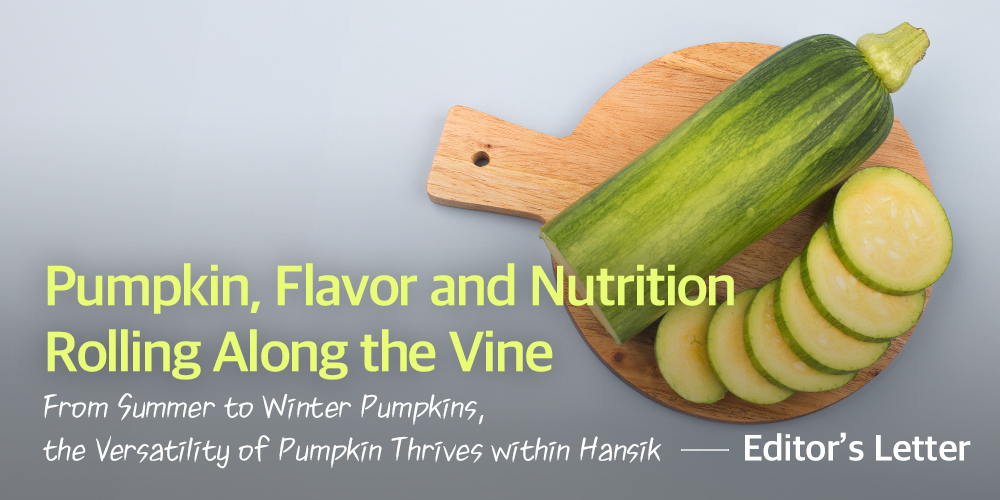
Hobak (pumpkin), a familiar ingredient on the dining table since ancient times, is cherished for its unique flavor and texture. It is a friendly ingredient that suits any constitution and is rich in nutrients, earning it the title of a healthy vegetable and a versatile remedy in the kitchen. Various types of hobak, including native local varieties, western-style hobak, and new varieties with unique colors and shapes that have been developed through various methods, have garnered attention even in fine dining.
The common hobak, once overlooked, has now firmly established itself at the forefront of culinary trends. Let's explore the diverse hobak dishes suitable for both comforting meals and elegant dining experiences.
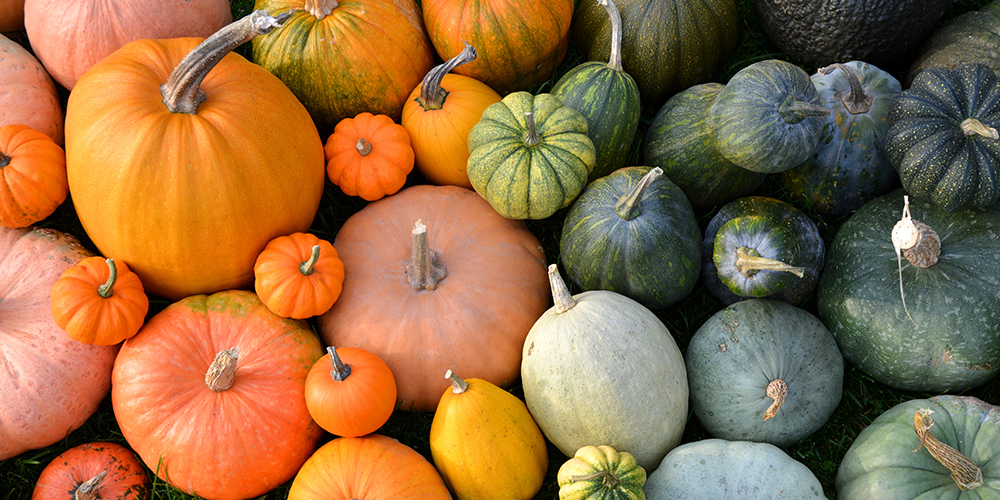
Aehobak: From a monk's side dish to royal cuisine, the beloved national vegetable
Aehobak (zucchini), which we are most familiar with, is a representative summer vegetable that possesses a robust vitality, enduring even under the scorching sun without withering. With its tender flesh and sweet taste, it can be enjoyed in various dishes such as stews, stir-fries, and pancakes.

In particular, aehobak is widely used in temple cuisine. It is rich in moisture and is easily digested and absorbed compared to other types of pumpkin, making it an excellent ingredient even for those with digestive disorders. In temples, aehobak with its clear greenish hue and glossy appearance is often enjoyed lightly stir-fried or steamed, or thinly sliced, dried, and stored for later consumption.
Venerable Seonjae , the first master of temple cuisine in the Jogye Order, introduces “Aehobak Pyeonsu” as one of the representative hobak dishes. Pyeonsu is a type of mandu (dumpling) made with vegetables, and it is primarily eaten in the summer. The choices of vegetables for Pyeonsu include aehobak, cucumber, and mushrooms, which are less easily spoiled in the hot summer weather. Pyeonsu makes an excellent dish especially for temples that prepare a variety of mandu dishes utilizing seasonal ingredients. After shaping the dumplings beautifully, they are boiled and then rinsed in cold water before being served with choganjang (vinegar soy sauce ). These refreshing and light dumplings delightfully bring back your appetite lost from the scorching heat.
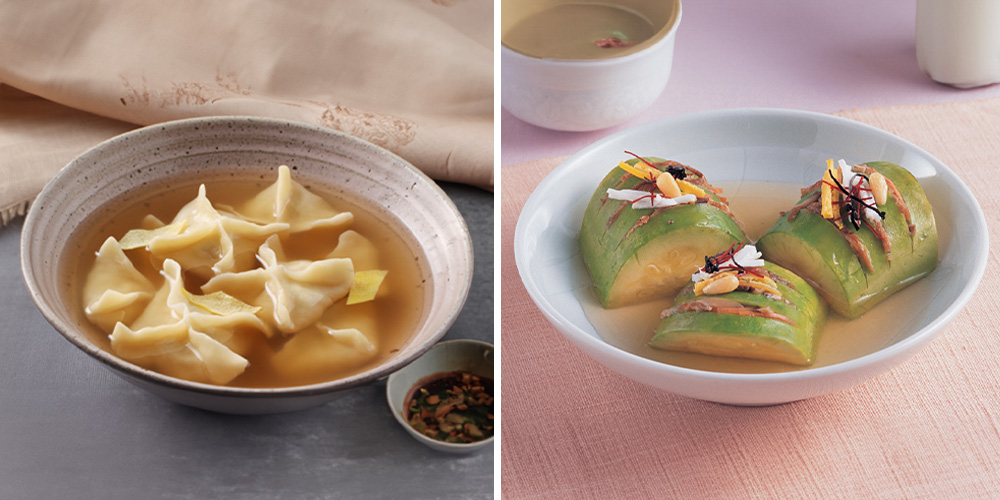
▲ The summer mandu called "Pyeonsu," means a shape floating on water, and "hobakseon," a stuffed pumpkin dish, are examples of Hansik featuring pumpkin.
Hobak has also been a significant ingredient in royal court cuisine. The late Hwang Hye-seong , a holder of Intangible Cultural Heritage No. 38 and a master of Joseon Royal Court Cuisine, left behind various recipes for "seon" dishes, with "hobakseon" being one of them. Hobakseon is a dish enjoyed in royal court cuisine as well as in the local cuisine of Gyeongsang-do (Gyeongsang Province) mainly among the noble houses, where aehobak is steamed after being stuffed with stir-fried beef, various mushrooms, carrots, and jidan (egg garnish). It is meticulously shaped into beautiful, bite-sized pieces, often served as an appetizer in a formal Korean meal or as an accompaniment for drinks. What are some other aehobak dishes that grace the tables of Korean households throughout the four seasons? Let’s take a look.
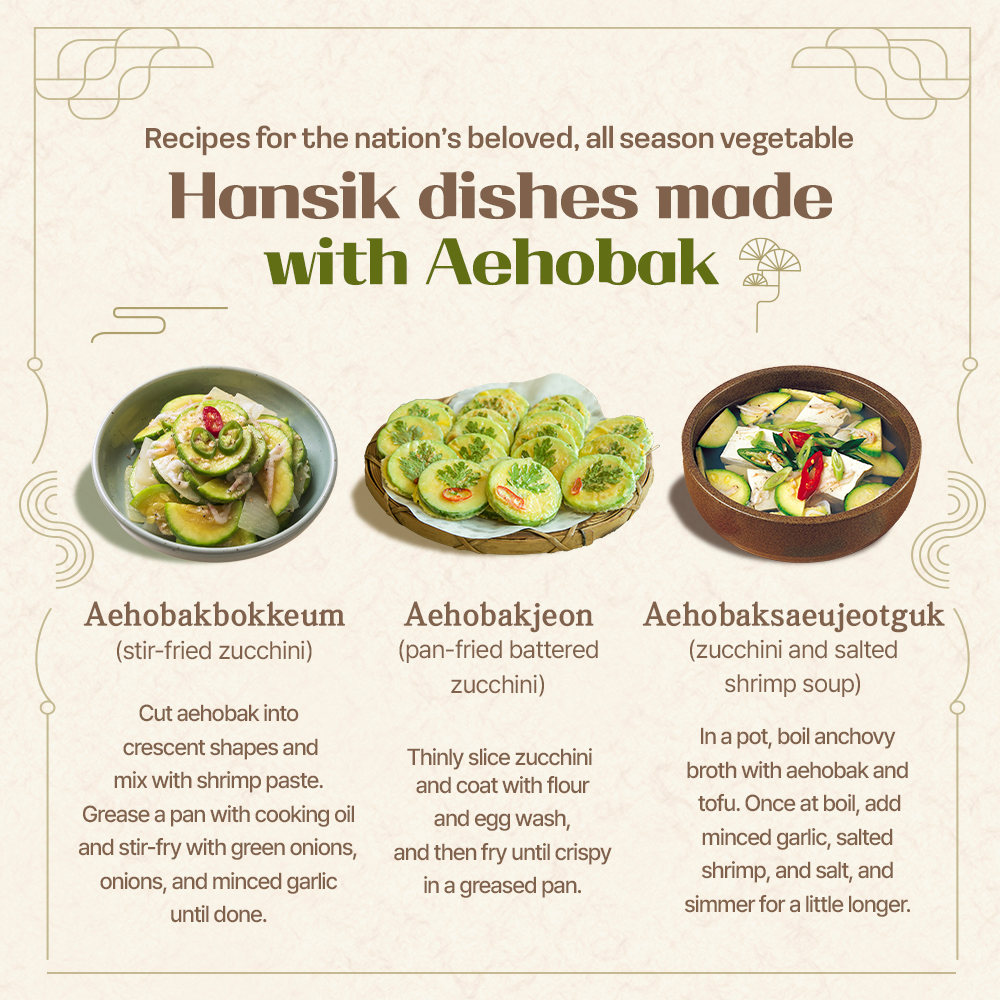
The Infinite Transformations of Hobak
If summer belongs to aehobak, then autumn brings neulgeunhobak (aged pumpkin) into the spotlight. Leaving behind the urban landscape filled with apartments and heading to a tranquil countryside hanok (traditional Korean house), one can witness the sight of neulguenhobak ripening to a golden yellow under the autumn sun on the spacious veranda. With its firm exterior, neulguenhobak boasts excellent storability, allowing households to preserve and consume pumpkin based dishes throughout the winter.
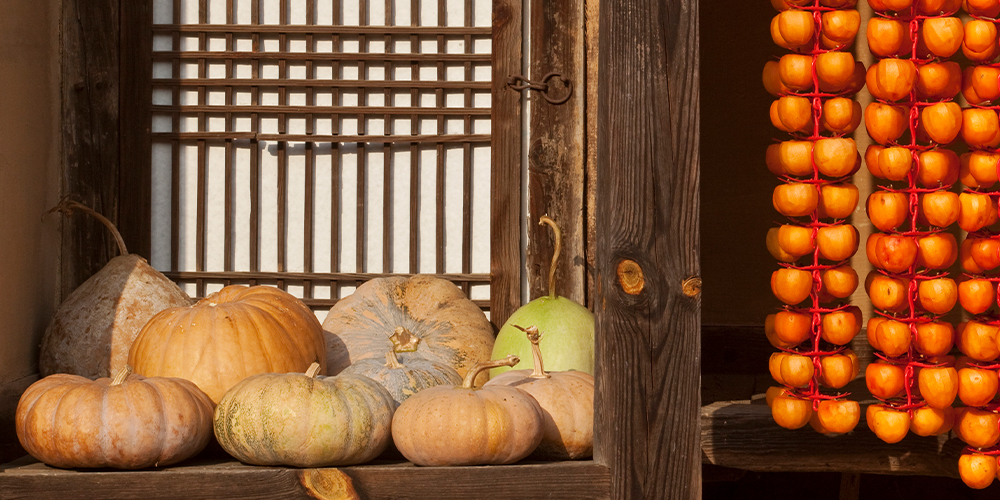
Since ancient times, in Chungcheong-do (Chungcheong Province), various cooking methods have been used to enjoy the taste of neulgeunhobak, including hobak-kimchi, hobakjuk (pumpkin porridge), hobak-gguldanji (honey pumpkin decoction) , and hobakjjigae (pumpkin stew) . Thinly sliced neulgeunhobak is salted and mixed with various other ingredients, such as radish leaves and kimchi seasoning, then fermented in a jar to create Chungcheong-style hobak-kimchi. By adding water to this fermented hobak-kimchi and boiling it, a delicious Chungcheong-style hobakjjigae (pumpkin stew) is prepared in no time.
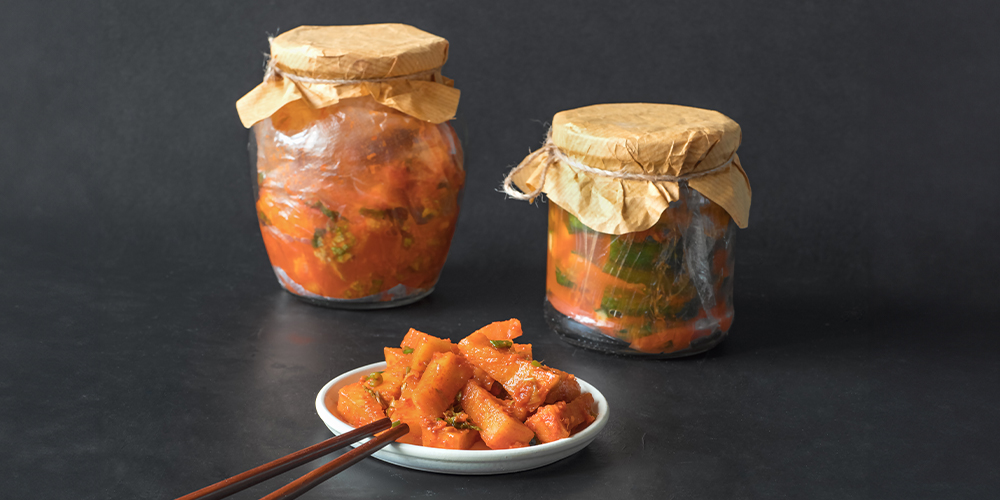
In addition, there are various ways to enjoy neulgeunhobak across different regions. For example, in Jeju, there is a delicacy called "galchihobakguk," which is made by boiling pumpkin with galchi (cutlassfish), a local specialty. During times when special snacks were scarce, people in Gyeongsang Province enjoyed "neulgeunhobakjeon (pan-fried battered aged pumpkin)" as a winter snack. Additionally, in Gyeonggi-do (Gyeonggi Province), there is "hobaksikhye," pumpkin sweet rice punch, known for its delicious sweetness. There is no one correct way to enjoy neulgeunhobak in each region. Thus, hobak continues to enrich our dining tables in various forms, adapting to each region's culture and natural environment.
There's no waste when it comes to using hobak
Hobak isn't just about its fruit. From the fruit to the leaves, flowers, stems, and seeds, every part can be cooked and eaten without wasting anything. When lightly steamed hobak leaves are wrapped with doenjangjjigae (soybean paste stew ), the refreshing flavor of the delicate leaves fill the mouth. The firm texture of the stem can be added to doenjangguk (soybean paste soup) or stir-fried like sweet potato stems for a delicious side dish.
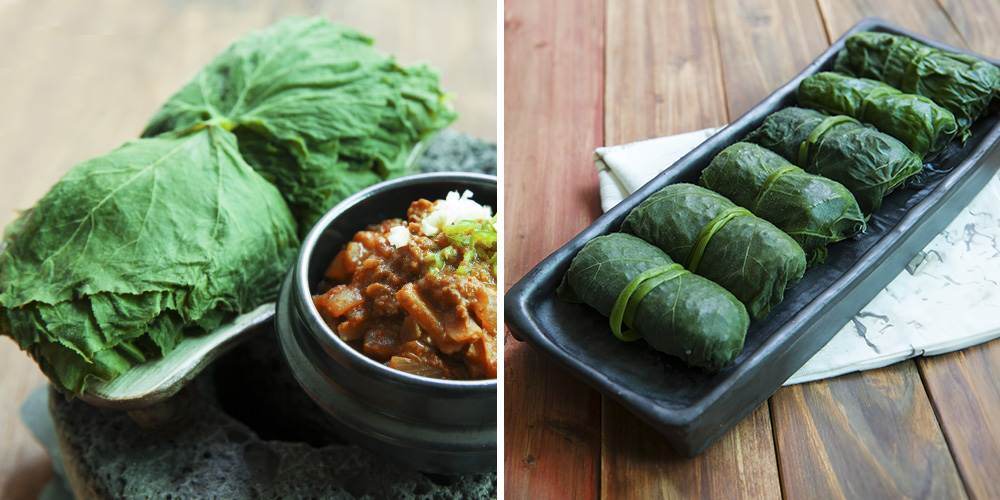
The blooming hobak flowers, like bright yellow stars, bring the feeling of hope and joy to the dining table. Make a filling by mixing ingredients such as tofu, corn, cheese, etc., stuff it into the hobak flowers, and then lightly fry them to create a delightful dish that looks and tastes wonderful. You can also make a filling with ingredients like pumpkin, shrimp, and minced pork, stuff it in the flowers, and then steam them to make delicate and colorful pumpkin flower dumplings. Roasting neulguenhobak seeds enhances their nutty aroma and flavor, making a terrific and nutritious snack.
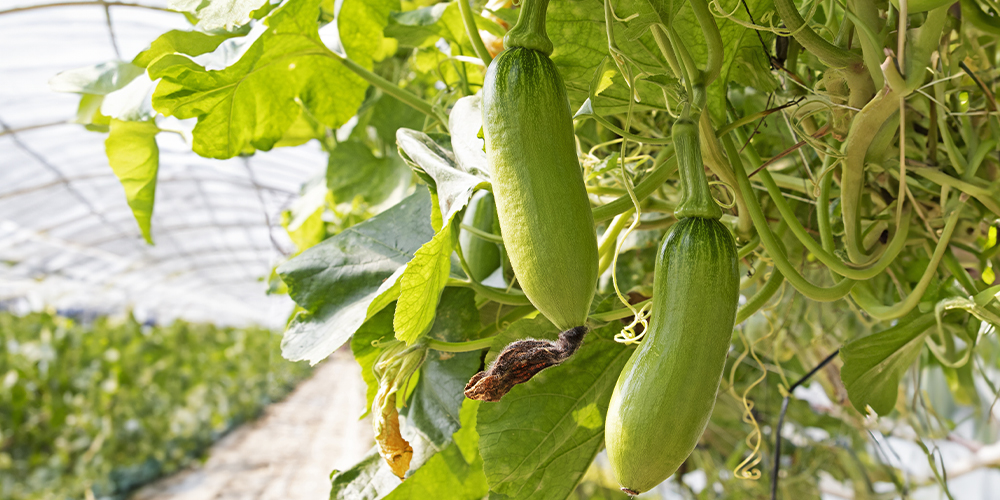
From early summer to late autumn, both the hobak flowers and fruits shine in various colors. The plump and nutritious hobak not only satiates our hunger but also fills our heart with warmth. It's no exaggeration to say that the beginning of gastronomy is influenced by the flavors of vegetables like hobak, which are readily available in our surroundings. Let's enjoy the versatile and delicious hobak in more sophisticated and flavorful dishes.
References <호박(Hobak), Rural Development Administration, Jinhan M&B, 2021>, <선재스님의 이야기로 버무린 사찰음식(Temple Food Seasoned with Stories by Ven. Seonjae), Ven. Seonjae, Bulgwang Publishing, 2014>, <3대가 쓴 한국의 전통음식(Traditional Hansik written by Three Generations ), Han Bok-ryeo, Hwang Hye-seong, Hanbokjin, Gyomunsa, 2010>, <윤숙자의 맛있는 한식 밥상( Master Yoon's Korean Cuisine - Korean Recipes) , Yoon Sook-ja, Gimmyoungsa , 2022>, Naver Knowledge Encyclopedia, Encyclopedia of Korean Culture, Encyclopedia of Korean Folk Culture

 한국어
한국어
 English
English






